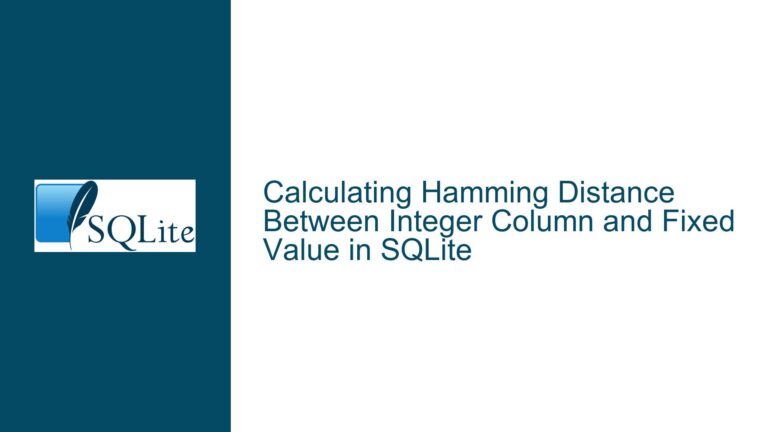Window Function Frame Behavior Without ORDER BY in SQLite
Window Frame Defaults and Implicit Ordering in SQLITE Window Functions
Issue Overview: Default Frame Behavior and Missing ORDER BY in Window Definitions
The core issue revolves around the interpretation of the default window frame specification (RANGE BETWEEN UNBOUNDED PRECEDING AND CURRENT ROW EXCLUDE NO OTHERS) when no ORDER BY clause is explicitly provided in a window definition. SQLite’s documentation states that the default frame specification uses RANGE, which requires the window’s ORDER BY clause to have exactly one term. However, when no ORDER BY is specified in the window definition, the behavior of the frame becomes ambiguous.
The user observed that a query such as SELECT count(*) OVER () FROM t1 returns 7 for all rows, suggesting that the entire partition (all rows) is included in the window frame. This contradicts the expectation that CURRENT ROW would restrict the frame incrementally. When an explicit ORDER BY is added to the window (e.g., ORDER BY random()), the frame behaves as a cumulative count, implying that the CURRENT ROW boundary is now being respected. The confusion arises from the interplay between the default frame specification, the absence of an explicit ORDER BY, and SQLite’s handling of implicit ordering.
Key observations include:
- Default Frame Activation: The default
RANGEframe requires anORDER BYclause to define peer groups (rows with equal values in theORDER BYcolumn). WithoutORDER BY, all rows are considered peers, leading the frame to include all rows in the partition. - Implicit vs. Explicit Ordering: When no
ORDER BYis present in the window definition, SQLite does not enforce an implicit order for frame boundaries. TheCURRENT ROWeffectively becomes meaningless because there is no ordering to define a "current" position. - PostgreSQL Comparison: PostgreSQL explicitly documents that the default frame includes all rows when
ORDER BYis omitted, aligning with SQLite’s observed behavior. However, SQLite’s documentation does not emphasize this detail, leading to ambiguity.
Possible Causes: Misalignment Between Frame Specification and Ordering Context
Missing ORDER BY Clause in Window Definition
The absence of anORDER BYin the window definition removes the mechanism for defining peer groups and frame boundaries. TheRANGEframe type relies on ordering to determine which rows are included in the frame. Without anORDER BY, SQLite treats all rows as a single peer group, causing the entire partition to be included in the frame. This explains whycount(*) OVER ()returns the total row count for every row: the frame spans all rows.Ambiguity in Default Frame Rules
SQLite’s documentation states that the default frame isRANGE BETWEEN UNBOUNDED PRECEDING AND CURRENT ROW. However, this default only applies if the window has anORDER BYclause. WhenORDER BYis omitted, the frame defaults toROWS BETWEEN UNBOUNDED PRECEDING AND UNBOUNDED FOLLOWING(implicitly), even though this is not explicitly stated. This discrepancy between documented and actual behavior leads to confusion.Implicit Reliance on Physical Row Order
SQLite does not guarantee a stable implicit order for rows unless anORDER BYis specified in the outer query. However, thePRAGMA reverse_unordered_selectscan reverse the default row order, exposing the lack of a defined ordering context for window frames. This creates non-deterministic results when relying on implicit ordering.Misinterpretation of CURRENT ROW in Range Frames
TheCURRENT ROWboundary in aRANGEframe depends on theORDER BYclause to define equivalence classes (peers). WithoutORDER BY, there are no peers, andCURRENT ROWexpands to include all rows, as there is no logical way to partition the data.
Troubleshooting Steps, Solutions & Fixes: Clarifying Frame Behavior and Ensuring Determinism
Explicitly Define ORDER BY in Window Definitions
To ensure deterministic frame boundaries, always include anORDER BYclause when usingRANGEframes. For example:SELECT count(*) OVER (ORDER BY a RANGE BETWEEN UNBOUNDED PRECEDING AND CURRENT ROW) FROM t1;This forces the frame to respect the ordering of column
a, creating incremental counts.Use ROWS Instead of RANGE When Ordering Is Absent
If ordering is irrelevant, explicitly define the frame asROWS BETWEEN UNBOUNDED PRECEDING AND UNBOUNDED FOLLOWINGto include all rows:SELECT count(*) OVER (ROWS BETWEEN UNBOUNDED PRECEDING AND UNBOUNDED FOLLOWING) FROM t1;This bypasses the need for an
ORDER BYclause and clarifies intent.Test with PRAGMA reverse_unordered_selects
To detect implicit reliance on physical row order, enable the pragma:PRAGMA reverse_unordered_selects = 1; SELECT count(*) OVER () FROM t1;If the results change, the query depends on undocumented ordering. Refactor the query to include an explicit
ORDER BY.Leverage WINDOW Clauses for Reusability
Define named window specifications to reduce ambiguity:SELECT count(*) OVER win FROM t1 WINDOW win AS (ORDER BY b RANGE BETWEEN UNBOUNDED PRECEDING AND CURRENT ROW);This makes the frame and ordering requirements explicit.
Consult Documentation for Frame Defaults
Key excerpts from SQLite’s documentation:- "If there is no ORDER BY clause, then all rows are considered peers."
- "The default frame specification is
RANGE BETWEEN UNBOUNDED PRECEDING AND CURRENT ROWif ORDER BY is present, andRANGE BETWEEN UNBOUNDED PRECEDING AND UNBOUNDED FOLLOWINGif ORDER BY is omitted."
Avoid Implicit Ordering Assumptions
Never assume that rows are processed in insertion order or primary key order. UseORDER BYin the outer query if a specific output order is required, but recognize that this does not affect window frame calculations unless the window itself includesORDER BY.Cross-Database Validation
Compare behavior with PostgreSQL to identify intentional deviations:-- PostgreSQL SELECT count(*) OVER () FROM t1; -- Returns 7 for all rowsThis confirms that the default frame includes all rows when
ORDER BYis omitted, aligning with SQLite’s behavior. Use this to inform expectations.
By addressing the interplay between frame specifications, ordering contexts, and documentation gaps, users can avoid pitfalls related to window function behavior in SQLite. The solutions emphasize explicitness in defining frames and orders, leveraging pragmas for testing, and aligning with documented defaults.






